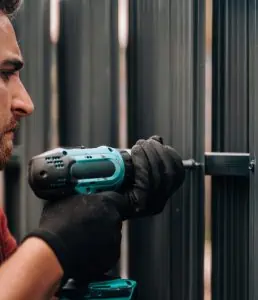How to Attach Wire Fencing to a Metal Frame?
Wire fencing is a versatile way to enclose your yard and keep animals in pens. It’s also a common material for decorative fences. Whether you’re attaching wire fencing to a metal frame for an ornamental or agricultural purpose, knowing how to do it is an essential skill to have.
(Looking for a privacy vinyl fence contractor? Contact us today!)

To construct a wire fence, you need to be welded or woven wire mesh to fill between posts. Woven wire is stronger than welded wire because it has heavier gauge wire strands and a special knot that ties them together at intersecting points.
Alternatively, you can use cattle panels, sheep panels, or hog panels for your infill. These panels have a flat, rigid surface that can be cut to fit any size of a fence post.
Start by measuring each side of your fence. This will allow you to figure out how much of a roll of welded wire to buy. Welded wire comes in rolls of 25, 50, or 100 feet, depending on the size of your fence. You will need to divide the total length by 7 or 10 feet to determine how many fence posts you need.
If your fence will have a gate, install it last. It is easier to put the gate between two posts rather than on top of one. In addition, it will be more stable. Putting the gate on top of one post will cause it to sag and be harder to open.
Once you have the welded wire set, add another layer to each post. This can be done with chain-link fabric, which is a good choice for a low-profile look, or with wire mesh that can be pulled tighter than chain-link.
Begin with one of the terminal posts, placing chain-link fabric along the outside of the fence line to the next terminal post. Fasten evenly spaced tension bands (already on the post) to the fabric combination using 5/16″ x 1-1/4″ carriage bolts with heads to the outside of the fence.
Then, insert one length of top rail through the line post closest to the terminal post and slip a rail end onto it. Apply a rail end band to the top rail and secure it to the terminal post with a 5/16″ x 1-1/4″ carriage bolt with the head to the outside of the fence (Figs. 8 and 9).
When you reach the next terminal post, measure carefully and cut the top rail to fit tightly between the last length of the top rail and the rail end. Repeat steps 1-4, and use the same rail end band and carriage bolts to secure the other end of the top rail to the terminal post.
To finish, insert a stretcher bar into the hole between the top rail and the fence frame and use a “come-along” winch to pull the wire mesh tight. Hammer 1 3/4-inch galvanized fence staples every 3 inches to hold the mesh in place.
Keeping your fence level is important to ensure it stands up straight and keeps the animals in the pens. If you go off-level, it will be difficult to get back on track and will look unsightly. This is especially true if you are building an electric fence, where you can’t just use the force of the wind to keep the fence level.

